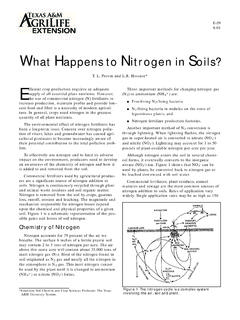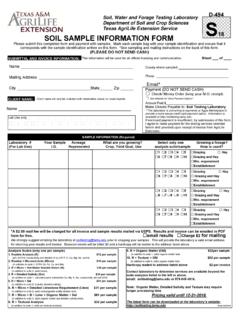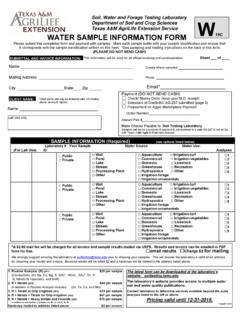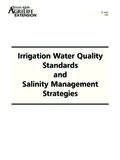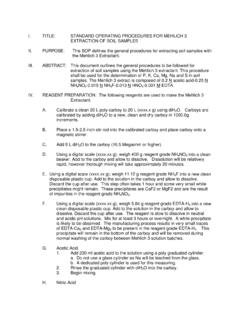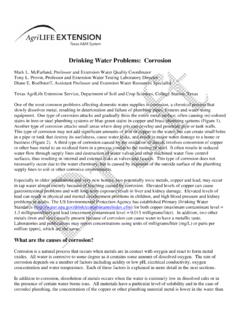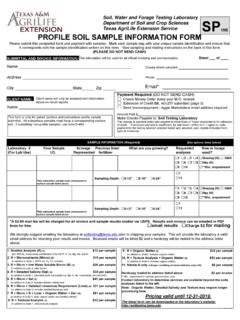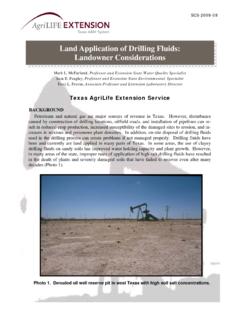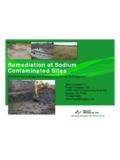Transcription of Managing Soil Salinity
1 If your soil has a high Salinity content, the plants growing there will not be as vigorous as they would be in normal soils. Seeds will germinate poorly, if at all, and the plants will grow slowly or become stunted. If the Salinity concentration is high enough, the plants will wilt and die, no matter how much you water soil testing can identify your soil s Salinity levels and suggest measures you can take to correct the specific Salinity problem in your and saltThe terms salt and Salinity are often used inter-changeably, and sometimes incorrectly. A salt is sim-ply an inorganic mineral that can dissolve in water. Many people associate salt with sodium chloride common table salt. In reality, the salts that affect both surface water and groundwater often are a combina-tion of sodium, calcium, potassium, magnesium, chlo-rides, nitrates, sulfates, bicarbonates and carbonates (Table 1).These salts often originate from the earth s crust. They also can result from weathering, in which small amounts of rock and other deposits are dissolved over time and carried away by water.
2 This slow weather-ing may cause salts to accumulate in both surface and underground waters. The surface runoff of these dissolved salts is what gives the salt content to our oceans and lakes. Fertilizers and organic amendments also add salts to the of salts on plantsAs soils become more saline, plants become unable to draw as much water from the soil . This is because the plant roots contain varying concentrations of ions (salts) that create a natural flow of water from the soil into the plant the level of Salinity in the soil nears that of the roots, however, water becomes less and less likely to enter the root. In fact, when the soil Salinity levels are high enough, the water in the roots is pulled back into the soil . The plants become unable to take in enough water to grow. Each plant species naturally contains varying levels of root salts. This is why some plants can continue to thrive when others have the Salinity concentration in the soil is high enough, the plant will wilt and die, regardless of the amount of water applied.
3 Figure 1 shows how the var-ious salt concentrations affect the movement of water from the soil to buildupSalinity is of greatest concern in soils that are:n Irrigated with water high in salts;n Poorly drained, allowing for too much evapora-tion from the soil surface;n Naturally high in salts because very little salt leaches out;n In areas where the water table (the level or depth to free-flowable water in the soil ) is shallow; orn In seepage zones, which are areas where water from other locations (normally up slope) seep major source of Salinity problems is usually irrigation water. This is a gradual process the salts must accumulate over time before any effects are E-60 3-12 Managing soil SalinityTony Provin and Pitt** Professor and Extension soil Chemist, Extension Program Specialist; The Texas A&M University 1. Typical salts found in irrigation water. Common Chemical Chemical Name Name FormulaTable salt Sodium chloride NaClGlauber s salt Sodium sulfate Na2SO4 Baking soda Sodium bicarbonate NaHCO3 Epsom salt Magnesium sulfate MgSO4 Gypsum Calcium sulfate CaSO4 2H2 OStreet salt Calcium chloride CaCl2 2H2 OMuriate of potash Potassium chloride KClMuriate of sulfate Potassium sulfate K2SO42seen.
4 Fortunately, plants take up many salts in the form of nutrients. But when more salt is added to the soil than is removed, the plants will eventually be affected. In some soils, irrigation and rainwater move through the soil to leach out the Salinity . Leaching occurs when water moves materials (such as salts or organic materials) downward through the soil . Several soil factors can inhibit leaching: a high clay content; compaction; a very high sodium content; or a high water table. Salt problems occur when water remains near the surface and evaporates, and when salts are not dissolved and carried below the root zone. Soils naturally high in soluble salts are usually found in arid or semi-arid regions, where salts often accumulate because there is not enough rainfall to dis-solve them and leach them out of the root zone. Salt spray near coastlines can also cause salts to build up in the soil . In areas with shallow water tables, water contain-ing dissolved salts may move upward into the rooting zone.
5 This occurs by capillary action (similar to the way a wick works), where evaporation serves as the suction of water up through the soil (Fig. 2). Water moves the farthest through finer clay and clay loam soils; it moves less in medium-textured soils (loams); and least in coarser, sandy testingTo determine the type of problem in your soil , col-lect a soil sample and have it tested. The best indica-tor of the extent of a salt problem is a detailed Salinity analysis, in which water is extracted from a paste. This test measures the pH, electrical conductivity (EC) and water-soluble levels of the soil . EC is a measure of the amount of dissolved salts in the paste of soil and Texas Agricultural Extension Service conducts several types of soil tests, including detailed Salinity analyses. For more information on soil testing, see Extension publication L-1793, Testing Your soil : How to Collect and Send Samples or check the Web site of the soil , Water, and Forage Testing Laboratory at The laboratory s phone num-ber is (979) soilsSalt buildup can result in three types of soils: saline, saline-sodic and sodic.
6 Saline soils are the easiest to correct; sodic soils are more difficult. Each type of soil has unique properties that require special 1. Increased salts in root zone can result in decreased water uptake by soilsSaline soils contain enough soluble salts to injure plants. They are characterized by white or light brown crusts on the surface. Saline soils usually have an EC of more than 4 mmho generally found in saline soils include NaCl (table salt), CaCl2, gypsum (CaSO4), magnesium sul-fate, potassium chloride and sodium sulfate. The calcium and magnesium salts are at a high enough concentration to offset the negative soil effects of the sodium pH of saline soils is generally below The normal desired range is to , but many Texas soils are naturally to Leaching the salts from these soils does not increase the pH of saline soilsSaline-sodic soils are like saline soils, except that they have significantly higher concentrations of sodi-um salts relative to calcium and magnesium soils typically have an EC of less than 4 mmho cm-1, and the pH is generally below The exchangeable sodium percentage is more than 15 per-cent of the cation exchange capacity (CEC).
7 CEC is a measure of the soil s capacity to hold cations, namely, calcium, magnesium, potassium, sodium, hydrogen and aluminum. The higher the CEC, the more prob-lematic the removal and remediation of the salt moves through these soils much as it does in saline soils, although the steps for correcting saline-sodic soil are different. Simply leaching the salts from this soil will convert it from saline-sodic to sodic soilsSodic soils are low in soluble salts but relatively high in exchangeable sodium. Sodic soils are unsuit-able for many plants because of their high sodium concentration, which may cause plant rooting prob-lems, and because of their high pH, which generally ranges from to high sodium levels disrupt both the chemi-cal and physical composition of soil clays. As a result, the soil surface has low permeability to air, rain and irrigation water. The soil is sticky when wet but forms hard clods and crusts upon phenomenon may not occur in very sandy soils because they lack clay content.
8 Salt problemsWhen salts accumulate in soils, problems arise for two main reasons: the soil becomes less permeable, and the salt damages or kills the first problem is associated with the soil struc-ture. In sodic soils, high levels of exchangeable sodium cause the individual sand, silt and clay particles to be separated and not clumped together into larger dispersion makes the soil tight and impervi-ous, so that it allows little air, rain or irrigation water to permeate into the soil . Therefore, the plants may not receive enough moisture and oxygen to grow. Salts may accumulate on the soil surface because they can-not leach out of the root can also be damaged by salt effects or toxic-ity. In saline and saline-sodic soils, high concentrations of soluble salts reduce the amount of available water for plants to use. High levels of sodium can be toxic to certain plants. Also, the very high soil pH in high-salt soils greatly changes the nutrients available to the plants. These Figure 2.
9 Leaching is the process of adding sufficient water to the soil to dissolve salts and carry them out of the root When the salt concentration in the soil is less than that in the plant, water moves from the soil into the When the salt concentration in the soil is equal to that of the plant, there is no net movement of When the salt concentration in the soil is greater than that of the plant, water moves from the plant into the soil . 4high pH levels change the ionic form of many plant nutrients to forms that make them unavailable to salt-affected soilsSalt-affected soils can be corrected by:n Improving drainagen Leachingn Reducing evaporationn Applying chemical treatmentsn A combination of these methodsImproving drainage: In soils with poor drainage, deep tillage can be used to break up the soil surface as well as claypans and hardpans, which are layers of clay or other hard soils that restrict the downward flow of water. Tilling helps the water move downward through the deep tillage will help temporarily, the parts of the soil not permanently broken up may reseal.
10 Leaching: Leaching can be used to reduce the salts in soils. You must add enough low-salt water to the soil surface to dissolve the salts and move them below the root zone. The water must be relatively free of salts (1,500 - 2,000 ppm total salts), particularly sodi-um salts. A water test can determine the level of salts in your works well on saline soils that have good structure and internal drainage. To leach a highly saline soil , you may need to apply as much as 48 acre-inches of water. An acre-inch is the volume of water that would cover 1 square acre to a depth of 1 inch (27,152 gallons).Testing is often needed to determine how much water is needed to correct a particular soil . The test-ing laboratory can advise on how much water to add. After an application, the soil often must be retested to determine whether enough salts were leached saline soils should be leached using several applications, so that the water can drain well. Here again, drainage can be a problem. If the water cannot infiltrate the soil , the salts cannot be dissolved and leached out of the evaporation: Applying residue or mulch to the soil can help lower evaporation treatments: Before leaching saline-sodic and sodic soils, you must first treat them with chemi-cals, to reduce the exchangeable sodium content.
